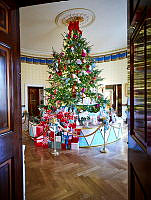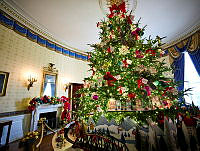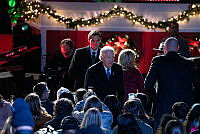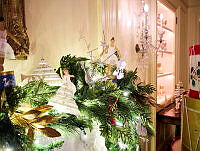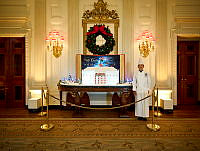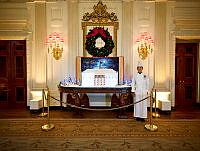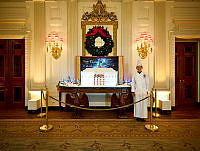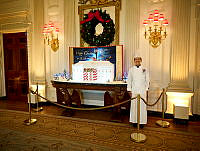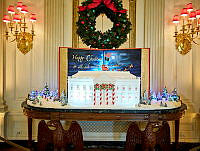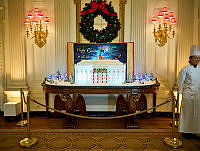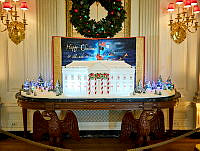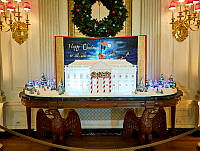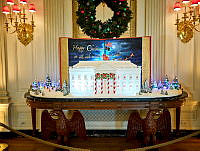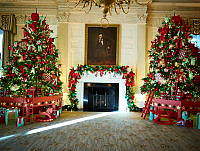Rubenstein Center Scholarship
The Life and Presidency of Richard M. Nixon
The Official 2022 White House Christmas Ornament Historical Essay
Richard Milhous Nixon was born on January 9, 1913, in Yorba Linda, California. The second of five sons, he graduated from Whittier College and Duke University School of Law and returned to California to practice law. Around this time, he met Patricia Ryan, and the couple began dating. They were married on June 21, 1940, and raised two daughters together—Patricia (called “Tricia”) and Julie.
During World War II, Nixon joined the United States Navy and rose to the rank of lieutenant commander, serving on active duty in the South Pacific. In 1946, he was elected to the U.S. House of Representatives. Serving on the House Un-American Activities Committee (HUAC), Nixon became a national figure when he investigated State Department official Alger Hiss amid accusations that Hiss was a Soviet spy. Nixon won election to the U.S. Senate in 1950. In 1952, he was elected vice president under President Dwight Eisenhower and served for eight years. In 1960, he lost the presidential election to John F. Kennedy in one of the closest elections in American history. Disappointed but undeterred, Nixon waited for the right time to return to the national stage. The Republican Party nominated him for the presidency again in 1968, and during the campaign he promised to bring stability and order to the country, end the Vietnam War, and restore American prosperity. He received a majority of the Electoral College vote and plurality of the popular vote, defeating candidates Hubert Humphrey and George Wallace.1

President Nixon donated his official portrait by James Anthony Wills to the White House Collection in 1984.
White House Historical Association/White House CollectionOn January 20, 1969, Richard Nixon was inaugurated as the thirty-seventh president of the United States. During his time in the White House (1969–74), President Nixon sought to unite a divided nation after the social, political, and cultural turbulence of the 1960s. He withdrew troops from Vietnam, established a diplomatic relationship with China, and de-escalated tensions with the Soviet Union. However, the Watergate scandal created new divisions, eventually leading to his resignation from office.
In response to President Lyndon B. Johnson’s Great Society programs, Nixon contended that the federal government had grown too large to operate effectively. On August 8, 1969, President Nixon delivered a televised address from the White House, explaining his New Federalism domestic policy framework. He outlined plans to decentralize some government programs, returning powers to state and local governments.2 Nixon’s New Federalism was met with mixed results. His welfare reform plans were ultimately defeated, but Nixon’s New Federalism influenced the eventual creation of federal block grant programs.
Nixon confronted other serious policy challenges. Rising stagflation (a situation marked by high unemployment and increasing inflation) continued to affect the economy. In 1971, Nixon signed an executive order freezing prices and wages in the United States for a period of ninety days. In addition to these economic issues, the United States faced an energy crisis when the Organization of Petroleum Exporting Countries (OPEC) raised oil prices worldwide and embargoed exports to the United States, resulting in increased prices and shortages.3

President Nixon is seen with Elvis Presley in the Oval Office, December 21, 1970. This iconic image is one of the most popular held in the collection of the National Archives.
Nixon Presidential Materials Project, National Archives and Records AdministrationDespite these challenges, Nixon succeeded in several domestic policy areas, including space exploration, environmental protection, and health research. On July 20, 1969, he watched live coverage of the Apollo 11 moon landing from the Oval Office and placed an interplanetary call to astronauts Edwin (“Buzz”) Aldrin and Neil Armstrong. Nixon also submitted a plan to Congress to create the Environmental Protection Agency (EPA) to oversee and regulate pollution, air and water quality, and waste disposal. The agency began operation in December 1970.4 That year he signed amendments to the Clean Air Act and went on to sign the Endangered Species Act in 1973.5 In 1971, Nixon established the “war on cancer” when he signed the National Cancer Act, creating the National Cancer Institute.
Nixon also influenced areas of women’s and Native American rights. He hired more women into senior positions in the executive branch than any previous president and signed Title IX, giving girls and young women greater opportunity to participate in athletics. Nixon introduced a new “self-determination without termination” policy for Native Americans in line with his New Federalism framework. Under this policy shift, “termination” of Native American lands and tribal status halted, and Nixon argued for increased tribal autonomy.6

President and Mrs. Nixon visit the Great Wall of China, February 24, 1972.
Courtesy of Henry & Carole Haller and FamilyPresident Nixon also made significant contributions to American foreign policy. In 1969, he introduced the Nixon Doctrine, stating that although the United States would assist allied countries militarily and economically, such allies would need to furnish the manpower for their own defense. In November 1969, Nixon called for winding down U.S. involvement in Vietnam, announcing that he would begin the gradual withdrawal of troops from the conflict and allow the South Vietnamese soldiers to take over in a process called “Vietnamization.”7 At the same time, he also pursued the conflict with extensive bombing campaigns in North Vietnam, Laos, and Cambodia, attacking supply lines and sanctuaries. Antiwar protests continued to grow across the country, especially after a confrontation and tragedy at Kent State University in which the Ohio National Guard killed four students in 1970 after being mobilized by Governor Jim Rhodes.8
In February 1972, President Nixon visited the People’s Republic of China, ending a decades-long policy of noncommunication with the Communist country. Nixon opened up diplomatic relations with the People’s Republic of China, a step that improved economic and trade relations between the countries.9 This move also transformed relations between the United States and the Soviet Union, as Nixon’s vigorous pursuit of détente eased tensions between the world’s two major superpowers. Months after meeting with Chinese Communist Party Chairman Mao Zedong, Nixon traveled to Moscow to meet with Soviet leader Leonid Brezhnev. During this summit, the two leaders continued their discussions aimed at limiting the number of nuclear weapons in each country. On May 26, they signed the Strategic Arms Limitation Treaty (SALT I), which limited strategic missile defenses and the construction of missile defense sites.10

President Nixon greets U.S. Navy Lieutenant Commander John S. McCain, one of more than 1300 guests attending the dinner on the South Lawn for returning American POWs, May 24, 1973.
Richard M. Nixon Presidential Library and Museum/NARAAfter a successful first term, President Nixon ran for reelection, which he won in a landslide victory. However, his second term was largely consumed by the Watergate scandal. Nixon initially denied any White House staff involvement in the June 17, 1972, arrest of five men for burglarizing the Democratic National Committee (DNC) headquarters at the Watergate Complex in Washington, D.C.11 The Senate convened a special Watergate committee to investigate, President Nixon appointed a special prosecutor to uncover criminal wrongdoing, and journalists pursued the story.
Beginning in 1973, several senior White House officials resigned or were fired in relation to the scandal. Famously dubbed the “Saturday Night Massacre,” resignations at the Department of Justice and the removal of special prosecutor Archibald Cox in October drew bipartisan criticism of the president’s actions. The new special prosecutor subsequently subpoenaed the president’s recorded White House conversations. More popularly known as “the Nixon tapes,” they sparked an important legal and constitutional battle concerning executive privilege that eventually reached the U.S. Supreme Court.

On August 9, 1974, President Nixon resigned from office. After addressing cabinet members, staff, and White House employees, he and his family departed the White House by helicopter.
Richard Nixon Presidential Library and MuseumOn May 9, 1974, the House Judiciary Committee began impeachment proceedings against President Nixon. On July 24, 1974, the Supreme Court unanimously rejected the president’s interpretation of executive privilege and ordered that the tapes be turned over to investigators. Within weeks, Nixon announced his intention to resign. At noon on August 9, President Richard M. Nixon became the first and only president to resign the presidency.12
Following his resignation, Nixon returned to his home in San Clemente, California, and later retired to Saddle River, New Jersey. He remained an active former president, publishing nine books and his successors often consulted him on matters of state. Through the Richard Nixon Foundation, he raised money to build and launch the Richard Nixon Library and Birthplace in 1990. Richard Nixon died on April 22, 1994, at the age of 81. He was laid to rest at the Nixon Library next to his wife Pat, who had passed away the previous year.13

Mrs. Nixon meets with children from The Washington Hospital for Sick Children, October 21, 1971.
Richard Nixon Presidential Library and Museum/NARAFirst Lady Pat Nixon
“People are my project,” said Pat Nixon,14 and her time as first lady in the White House was defined by her dedication to community service, accessibility, historic preservation, and diplomacy. She was particularly passionate about volunteerism, encouraging community engagement and publicly supporting several charitable organizations as first lady, including the American Red Cross, the Girl Scouts, and the American Cancer Society.15

Mrs. Nixon oversaw the refurbishment of many rooms on the State and Ground Floors. She is seen here during a press preview of the refurbished Blue Room, May 15, 1972.
White House Historical AssociationPat Nixon worked to make the White House more accessible to all visitors, including those with visual or hearing impairments and other disabilities as well as international tourists. She achieved these objectives by adding sign language and audio interpretation, multilingual tour booklets, and wheelchair ramps.16 She also acquired more than six hundred items for the White House Collection and renovated and redecorated most of the rooms on the Ground and State Floors; most notably, she refurbished the Map Room into a sitting room.17 She spearheaded efforts to illuminate the exterior of the Executive Mansion at night and introduced new public tours of the White House, including the Spring and Fall Garden Tours.18

Mrs. Nixon is joined by the president as she leads children on a tour of the Rose Garden, April 14, 1973.
Richard Nixon Presidential Library and Museum/NARAPat Nixon’s impact went well beyond the walls of the Executive Mansion, as she traveled extensively throughout her time at the White House.19 In 1969, she went to Vietnam, meeting American troops and local children.20 In 1970, she brought relief supplies to Peru after a devastating earthquake.21 In 1972, she became the first first lady to visit Africa, stop- ping in Liberia, Ghana, and the Ivory Coast.22 That year she also accompanied her husband on important trips to the Soviet Union and China, where she mentioned a fondness for giant pandas to Chinese Premier Zhou Enlai. Her remark prompted the gift of two giant pandas to the Smithsonian’s National Zoo. The year 2022 marks the fiftieth anniversary of Pat Nixon’s “panda diplomacy” and five decades of partnership between conservation experts in the United States and China.

President and Mrs. Nixon (center) pose for a portrait in front of the Blue Room Christmas Tree, with Edward and Tricia Nixon Cox (left) and David and Julie Nixon Eisenhower (right), December 24, 1971.
Richard Nixon Presidential Library and Museum/NARATwo years after President Nixon’s resignation in 1974, Pat Nixon suffered a stroke; as a result, she participated in few public events, which included the opening ceremonies for the Richard Nixon Presidential Library and Museum, and the Ronald Reagan Presidential Library.23 Pat Nixon passed away on June 22, 1993.
Nixon Family Holiday Traditions
President Richard M. Nixon and First Lady Pat Nixon spent their five Christmases at the White House, Camp David, and their compound in Key Biscayne, Florida. Regardless of place, the president spent a considerable part of each holiday on the telephone, conversing with his family, cabinet members, and congressional leadership. He also spoke frequently with notable figures, such as former President Lyndon B. Johnson, former First Lady Mamie Eisenhower, and Reverend Billy Graham.24

First Lady Pat Nixon joins guests on the North Portico ahead of a White House Candlelight Tour, December 12, 1972.
Richard Nixon FoundationThe most memorable Nixon family Christmas took place at the White House in 1971, as the president and first lady celebrated with their two daughters, Tricia and Julie, as well as sons-in-law Edward Cox and David Eisenhower. Julie and David were married shortly before the Nixons moved into the White House. Tricia and Edward were married in June 1971 in an elegant Rose Garden ceremony, followed by a reception for nearly four hundred guests in the East Room. The photograph taken of the Nixon family that year in front of the Blue Room Christmas tree is one of the family’s favorite portraits from their White House years.25

Mrs. Nixon is joined by her daughter Julie Nixon Eisenhower in the State Dining Room to inspect a gingerbread house made by White House Assistant Chef Hans Raffert, December 13, 1971.
Richard Nixon FoundationThe Nixons continued many White House holiday traditions: they festively decorated the State Floor, hosted receptions, sent Christmas cards, and participated in three National Christmas Tree lightings.26 Mrs. Nixon also established new customs. In 1969, she started a special Candlelight Tour for the general public so people could see the decorations after work, and she attended the annual holiday party for the children of diplomats. She also began the tradition of displaying an official White House gingerbread house in the State Dining Room.
The 2022 Official White House Christmas Ornament
The White House Historical Association’s Official 2022 White House Christmas Ornament commemorates the presidency of Richard Milhous Nixon. The ornament represents what has become one of the home’s most cherished holiday traditions—the official White House gingerbread house. Prior to Nixon’s presidency, gingerbread had been used for decorating Christmas trees, and, at times, gifts of gingerbread houses had been sent to the White House, but it was not until 1969 that the first official White House gingerbread house was created.27 That year Assistant Chef Hans Raffert built a traditional German A-frame style house for the Nixon family and decorated it with white icing as well as colorful candies and gumdrops. He continued making a gingerbread house in this fashion every year until his retirement in 1992.28

This 1999 gingerbread display in the State Dining Room included a group of landmarks created by Executive Pastry Chef Roland Mesnier. Seen here are the White House, the Washington Monument, the Jefferson Memorial, and Mount Vernon.
William J. Clinton Presidential Library and Museum/NARAWhite House gingerbread displays became larger and more elaborate under White House Executive Pastry Chef Roland Mesnier, who oversaw the creation of festive villages, childhood homes, castles, national monuments and historic sites, and marzipan sculptures of the first families and their pets. During the George W. Bush presidency, a gingerbread replica of the White House became the standard that continues today. Often molded out of chocolate and weighing around 300 pounds, these gingerbread houses are assembled and decorated by a team of confectionary experts and designed to complement the first lady’s choice of theme for that year’s decorations.

For the 2021 holidays, White House Executive Pastry Chef Susan Morrison created a gingerbread display to honor frontline responders and essential workers who served during the COVID-19 pandemic. Surrounding the White House are a hospital, fire station, police station, schoolhouse, post office, and grocery store.
David Wiegold for the White House Historical Association
The Official 2022 White House Christmas Ornament
David Wiegold for the White House Historical Association












